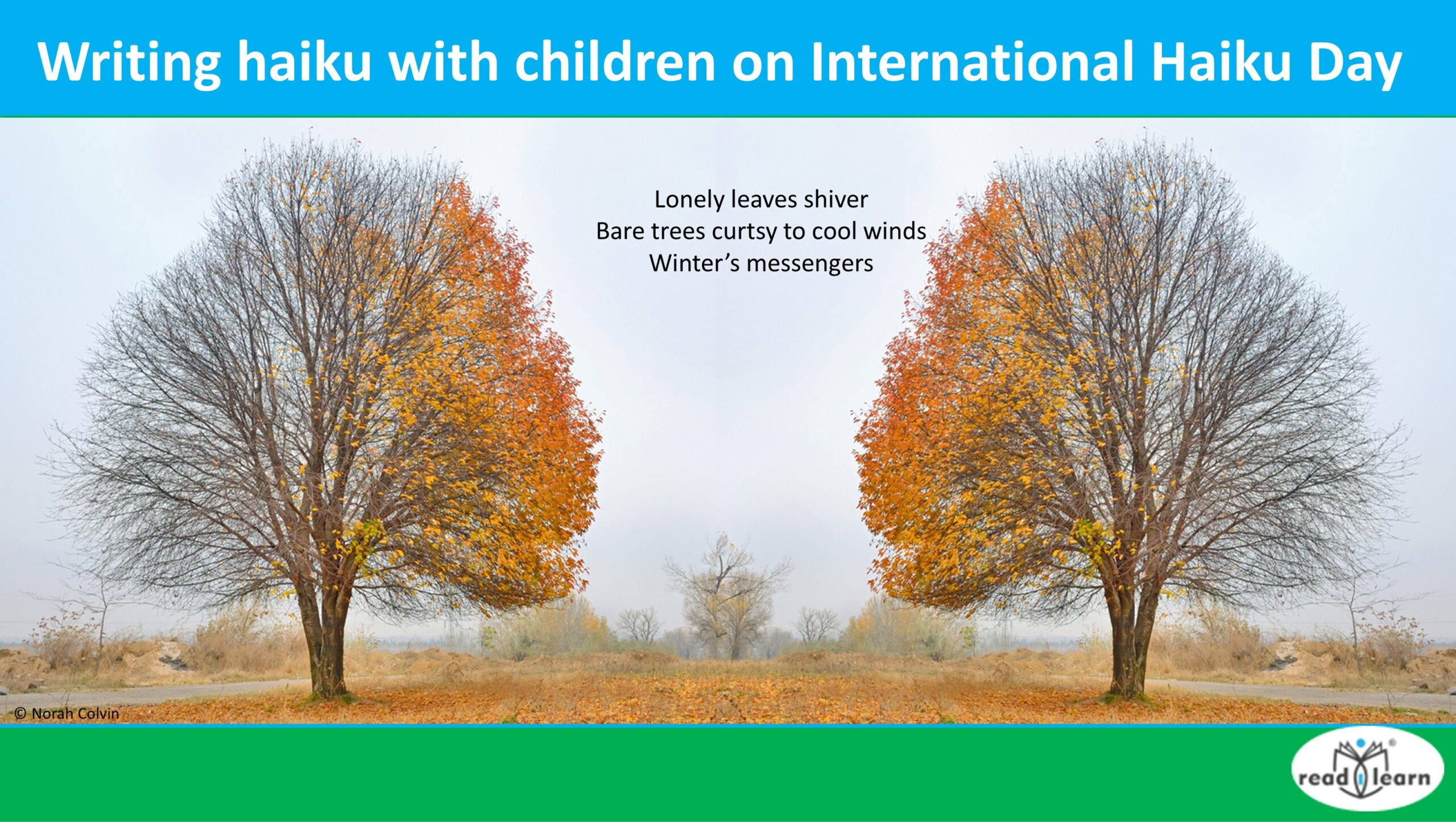What is Haiku?
Haiku is a short poem of only three lines with a very structured form. There only 17 syllables in the entire poem:
five on the first line
seven syllables come next
and five on the third
The purpose of the haiku is to capture a brief moment in time. Traditionally, it is written about the seasons but can be used to write poems on any topic. Haiku poetry often concludes with a feeling or observation. Sometimes the feeling is not explicit but is left for the reader to interpret.

What is a syllable?
Before attempting to write haiku, it is necessary to know what a syllable is. Whether teaching or revising syllables, readilearn has some resources to support you, including:

Fun with Syllables — the concept of syllabification is introduced as an auditory activity developing phonemic awareness.

Name games — teaching phonics, syllables and reading long words — suggests ways of introducing the concept to children using those most familiar words, their own names.

Syllable sorting cards — a set of 72 printable picture cards for sorting words that have one, two, three or more than three syllables.
Appreciating Haiku Poetry
It is also necessary to be familiar with the haiku form. The best way to become familiar is to read or listen to many different haiku poems.
Your school (or local) librarian may be able to assist with some collections of haiku or poetry books that include examples of haiku. There are many written for young children.
As you read the poems to the children, discuss with them the language used — including figurative language such as similes, metaphors and personification — and the feeling the poems evoke.
Present children with some written examples of haiku and explain the structure, clapping out the syllables on each line. Children may notice that not all poems adhere strictly to the structure. Some may deviate slightly. While you might encourage children to follow the structure closely when writing their own poems, you might also provide them with a little ‘poetic license’.
Gathering thoughts and Ideas
When preparing to write haiku, it is good to sit outside in nature. You may have a nature space or garden you could sit in, or even a big tree whose shade you could all rest in.
Encourage children to sit quietly and use all their senses (except taste) to make their observations. There should be no discussion at this stage, but you may guide their observations, almost like a guided exercise in mindfulness; for example, you might ask the children to:
Look — at the sky, its colour, the shape of the clouds, the sparkle of sunshine; the leaves of the trees and the way the light dances through them; the shadows on the ground
Listen — for the sounds of nature; for example: leaves rustling, insects buzzing, birds chirping, twigs crackling
Smell — the soil, the trees, the flowers
Feel — the breeze on their face or in their hair, the smoothness of stones, the roughness of bark, the spikes of grass
You could concentrate on one sense each day or use all senses to observe one phenomenon and build up their observations during the week.
After children have completed their observations lead them in a discussion of what they observed. Encourage them to use descriptive and figurative language.
Note: Each of the following steps may take place on subsequent days for one or more weeks.
Recording ideas
When you return to the classroom, provide children with time to record descriptions of their observations with words and phrases. Once again, encourage them to use descriptive and figurative language as this will help them when writing their poems. However, what is most important is for them to jot down as many ideas as they can.
Writing poems
Collaborative writing
Demonstrate writing a haiku poem by writing one together as a class using ideas that children have gathered.
For example, you may decide to write a poem about the tree under which you all sat.
- Ask children to share words and phrases they wrote about the tree. Write them on a chart.
- Discuss whether some of the ideas can be combined or expanded using descriptive or figurative language.
- Select three of those ideas to include in the poem.
- Write one idea on each line to make a poem of three lines.
- Read the poem to confirm it has the meaning you wish to convey.
- Count the number of syllables in each line.
- If necessary, discuss which words may be omitted or added, or ideas reworded to match the number of required syllables.
- Edit the poem.
- Rewrite the poem on a new chart.
- Read and enjoy.
Independent writing
Encourage children to use their notes and follow the same process for writing a haiku of their own. They should understand that it is not necessary to get it exactly right the first time they write it, but that it’s okay to revise and rewrite until they are happy with their words and its proximity to the haiku form.
Provide time for children to share their haiku with others.
If desired, print the haiku and compile into a book for the classroom or school library, or to share with other classes and parents.
These ideas for writing haiku with children are available to download as a PDF here.




Pamela
April 20, 2023This is great, Norah. and just as good for adults as for children. In my teaching of creative writing, I find that adults are intimidated by haiku. Interesting! So I “make” them write it every few months. It’s so good for us!!
Norah Colvin
April 20, 2023It is good for us, Pam. I’m pleased you ‘make’ your students write it. I’m sure they don’t mind. 🙂